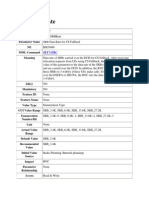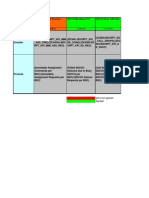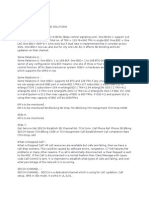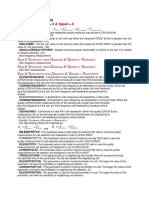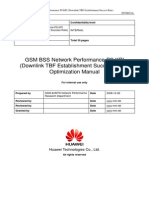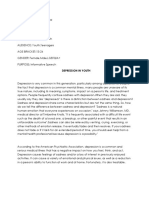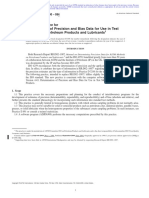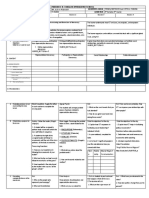Downlink TBF Establishment Success Rate Optimization Manual
Uploaded by
ivancho76Downlink TBF Establishment Success Rate Optimization Manual
Uploaded by
ivancho76GSM BSS Network Performance PS KPI (Downlink TBF Establishment Success Rate) Optimization Manual
Product Name
Product Version
GSM BSS Network Performance PS KPI (Downlink TBF Establishment Success Rate) Optimization Manual
Prepared by Reviewed by Reviewed by Granted by Date Date Date Date
GSM BSS Network Performance PS KPI (Downlink TBF Establishment Success Rate) Optimization Manual
Revision Record
Date Revision version Change Description Author
2012-2-22 9:26:04 a2/p2
Page 2 of 30
GSM BSS Network Performance PS KPI (Downlink TBF Establishment Success Rate) Optimization Manual
GSM BSS Network Performance PS KPI (Downlink TBF Establishment Success Rate) Optimization Manual
Keywords Downlink TBF, establishment success rate Abstract This manual mainly describes the method of collecting statistics about the downlink TBF establishment success rate and the methods of optimizing the downlink TBF establishment success rate. List of abbreviations Abbreviation PDCH PCU MS CQT KPI DT GPRS EDGE Full Spelling Packet Data Channel Packet Control Unit Mobile Station Call Quality Test Key Performance Index Drive Test General Packet Radio Service Enhanced Data rates for GSM Evolution
2012-2-22 9:26:04 a2/p2
Page 3 of 30
GSM BSS Network Performance PS KPI (Downlink TBF Establishment Success Rate) Optimization Manual
Contents
1.1 Counter Definition....................................................................................................................................................6 1.1.1 Definition in the Case of No MS Response .......................................................................................................6 1.1.2 Definition in the Case of No Available Resources ............................................................................................6 1.1.3 Definition in the Case of No MS Response or No Available Resources ...........................................................7 1.2 Theory.......................................................................................................................................................................7 2.1 Number of Successful Downlink TBF Establishments............................................................................................8 2.1.1 Description..........................................................................................................................................................8 2.1.2 Measurement Point.............................................................................................................................................8 2.2 Number of Failed Downlink TBF Establishments...................................................................................................9 2.2.1 Description..........................................................................................................................................................9 2.2.2 Measurement Point...........................................................................................................................................10 2.3 Number of Downlink TBF Establishment Attempts..............................................................................................10 2.3.1 Description........................................................................................................................................................10 2.3.2 Measurement Point...........................................................................................................................................10 3.1 Checking the Abis Link..........................................................................................................................................15 3.2 Checking the Delivery of Assignment Messages...................................................................................................16 3.2.1 Failed Downlink TBF Establishments Due to Overloaded CCCH..................................................................16 3.2.2 Failed Downlink TBF Establishments Due to No Channel Resources............................................................16 3.3 Checking the Air Interface......................................................................................................................................19 3.4 Checking Failed Downlink TBF Establishments Due to No Response from the MS............................................20 3.4.1 Failed Downlink TBF Establishments Due to Improper Parameter Configurations........................................20 3.4.2 Failed Downlink TBF Establishments Due to Incorrect Information Elements in Assignment Messages......22 3.4.3 Failed Downlink TBF Establishments Due to Imbalance Between the Uplink and the Downlink..................23 3.4.4 Checking the Feed System...............................................................................................................................24 3.4.5 Checking the KPIs of the PS Field...................................................................................................................24 4.1 Case 1: Low Success Rate of Downlink TBF Establishment Due to Incorrect Frequency-Hopping Parameter Settings in Czech Republic...........................................................................................................................................25 4.2 Case 2: Low Success Rate of Downlink TBF Establishment Due to No Responses from MSs After the PCU Is Upgraded......................................................................................................................................................................28
2012-2-22 9:26:04 a2/p2
Page 4 of 30
GSM BSS Network Performance PS KPI (Downlink TBF Establishment Success Rate) Optimization Manual
Figures
Successful establishment of downlink TBF on the CCCH.....................9 Successful downlink TBF establishment on the PACCH.......................9 Downlink TBF establishment attempts on the CCCH.........................11 Downlink TBF establishment attempts on the PACCH.......................11 Uplink and downlink TBF establishment procedure on the CCCH.......13 Overall analysis process.................................................................14 Analysis of the frame error rate of the G-Abis interface is normal.....26 Downlink packet assignment message............................................26 MA Numeber in the downlink packet assignment message...............27 Frequency-hopping information being null in the SI 13 message.......28
2012-2-22 9:26:04 a2/p2
Page 5 of 30
GSM BSS Network Performance PS KPI (Downlink TBF Establishment Success Rate) Optimization Manual
GSM BSS Network Performance PS KPI (Downlink TBF Establishment Success Rate) Optimization Manual
1
1.1 Counter Definition
Basic Principle
The definition of the downlink TBF establishment success rate varies with the assessment item.
1.1.1 Definition in the Case of No MS Response
If the network side delivers an assignment message to a mobile station (MS) but fails to receive the Packet Control Acknowledgement message from the MS, the number of failed downlink TBF establishments due to MS no response is added by one. The definition of the downlink TBF establishment success rate is as follows: Downlink GPRS TBF Establishment Success Rate = 1 - Number of Failed Downlink GPRS TBF Establishments due to MS No Response/Number of Downlink GPRS TBF Establishment Attempts Downlink EGPRS TBF Establishment Success Rate = 1 - Number of Failed Downlink EGPRS TBF Establishments due to MS No Response/Number of Downlink EGPRS TBF Establishment Attempts
1.1.2 Definition in the Case of No Available Resources
If the downlink TBF establishment fails because the resources such as channels and TFIs at the network side are unavailable, the number of failed downlink TBF establishments due to no channel is added by one. The definition of the downlink TBF establishment success rate is as follows: Downlink GPRS TBF Establishment Success Rate = 1 - Number of Failed Downlink GPRS TBF Establishments due to No Channel/Number of Downlink GPRS TBF Establishment Attempts
2012-2-22 9:26:04 a2/p2
Page 6 of 30
GSM BSS Network Performance PS KPI (Downlink TBF Establishment Success Rate) Optimization Manual
Downlink EGPRS TBF Establishment Success Rate = 1 - Number of Failed Downlink EGPRS TBF Establishments due to No Channel/Number of Downlink EGPRS TBF Establishment Attempts
1.1.3 Definition in the Case of No MS Response or No Available Resources
If the downlink TBF establishment fails because the network side fails to receive the Packet Control Acknowledgement message from an MS or the resources at the network side are unavailable, the number of failed downlink TBF establishments is add by one. The definition of the downlink TBF establishment success rate is as follows: Downlink GPRS TBF Establishment Success Rate = Number of Successful Downlink GPRS TBF Establishments/Number of Downlink GPRS TBF Establishment Attempts Downlink EGPRS TBF Establishment Success Rate = Number of Successful Downlink EGPRS TBF Establishments/Number of Downlink EGPRS TBF Establishment Attempts
1.2 Theory
The downlink TBF establishment success rate shows the downlink access performance and is an important counter for assessing the network. When the downlink TBF fails to be established, the network side continues to trigger the establishment of the downlink TBF in a short time because the network side has some data blocks that are not delivered. Therefore, the downlink TBF establishment success rate is slightly low in this case, but customer experience is not affected.
2012-2-22 9:26:04 a2/p2
Page 7 of 30
GSM BSS Network Performance PS KPI (Downlink TBF Establishment Success Rate) Optimization Manual
2
2.1.1 Description 2.1.2 Measurement Point
Signaling Procedure
2.1 Number of Successful Downlink TBF Establishments
This counter provides the number of successful downlink TBF establishments in a measurement period.
Successful downlink TBF establishments involve the following aspects: 1. Successful downlink TBF establishment on the CCCH The network side initiates the downlink TBF establishment procedure by sending an IMMEDIATE ASSIGNMENT message with Starting Time on the CCCH to the MS. When the starting time is reached, the network side sends a POLLING message to the MS to obtain a TA value. The BSC reserves block resources for the MS to respond with an assignment acknowledgement message. If the network side receives a Packet Control Acknowledgement message from the MS on the reserved block resources in the assigned channel, it indicates that the downlink TBF is established. In addition, the network side can calculate the TA value by using the Packet Control Acknowledgement message that is received. The following figure shows the procedure for establishing downlink TBFs on the CCCH. Each time the network side receives a Packet Control Acknowledgement message (see measurement point A), the value of the counter Number of Successful Downlink TBF Establishments is added by one.
2012-2-22 9:26:04 a2/p2
Page 8 of 30
GSM BSS Network Performance PS KPI (Downlink TBF Establishment Success Rate) Optimization Manual
Figure 1.1 Successful establishment of downlink TBF on the CCCH
MS
Network IMMEDIATE ASSIGNMENT (CCCH) POLLING(RRBP) PACKET Control Acknowledgement
A
2.
Successful downlink TBF establishment on the PACCH The network side can initiate the downlink TBF establishment procedure by sending a Packet downlink assignment message on the PACCH to the MS. The message contains the information about the block resources reserved by the network side for the MS to respond with an assignment acknowledgement message. If the network side receives a Packet Control Acknowledgement message from the MS on the reserved block resources in the assigned channel, it indicates that the downlink TBF is established. 2.1 shows the procedure for establishing the downlink TBF on the PACCH. Each time the network side receives a Packet Control Acknowledgement message corresponding to a Packet downlink assignment message (see measurement point A), the value of the counter Number of Successful Downlink TBF Establishments is added by one.
Figure 2.1 Successful downlink TBF establishment on the PACCH
MS
Network Packet downlink assignment
PACKET Control Acknowledgement
A
2.2 Number of Failed Downlink TBF Establishments
2.2.1 Description
This counter measures the number of failed downlink TBF establishments in a measurement period.
2012-2-22 9:26:04 a2/p2 Page 9 of 30
GSM BSS Network Performance PS KPI (Downlink TBF Establishment Success Rate) Optimization Manual
2.2.2 Measurement Point
Failed downlink TBF establishments involve the following aspects: 1. Failed downlink TBF establishments due to no channel If the BSC receives a new downlink PDU request from the SGSN but fails to establish a download TBF because channels are unavailable, the value of Number of Failed Downlink TBF Establishments due to No Channel is added by one. 2. Failed downlink TBF establishments due to MS no response In the procedure for establishing a downlink TBF, the BSC sends a POLLING message on the CCCH or sends a Packet downlink assignment message on the PACCH, and reserves block resources for the MS to respond with an assignment acknowledgement message. If the BSC does not receive a Packet Control Acknowledgement message from the MS on the reserved block resources, the BSC sends the IMMEDIATE ASSIGNMENT messages repeatedly until the maximum number of retry times is exceeded. Each time the maximum number of retrying times is exceeded, the value of Number of Failed Downlink TBF Establishments due to MS No Response is added by one.
2.3 Number of Downlink TBF Establishment Attempts
2.3.1 Description
This counter measures the number of downlink TBF establishment attempts in a measurement period.
2.3.2 Measurement Point
Downlink TBF establishment attempts involve the following aspects: 1. Downlink TBF establishment attempts on the CCCH The network attempts to establish the downlink TBF by sending the IMMEDIATE ASSIGNMENT message at the sub-timeslot corresponding to the CCCH group to which the MS belongs. Figure shows the procedure for the network side to send the IMMEDIATE ASSIGNMENT message on the CCCH. Each time the network side sends an IMMEDIATE ASSIGNMENT message (see measurement point A), the value of the counter Number of Downlink TBF Establishment Attempts is added by one.
2012-2-22 9:26:04 a2/p2
Page 10 of 30
GSM BSS Network Performance PS KPI (Downlink TBF Establishment Success Rate) Optimization Manual
Figure 1.1 Downlink TBF establishment attempts on the CCCH.
MS
Network IMMEDIATE ASSIGNMENT (On CCCH)
A
2.
Downlink TBF establishment attempts on the PACCH The network side can attempt to establish the downlink TBF by sending a PACKET DOWNLINK ASSIGNMENT message to an MS during the transmission process of the previous uplink TBF or the release process of the current downlink TBF. 2.1 shows the procedure for the network side to send the PACKET DOWNLINK ASSIGNMENT message on the PACCH. Each time the network side sends a PACKET DOWNLINK ASSIGNMENT message (see measurement point A), the value of the counter Number of Downlink TBF Establishment Attempts is added by one.
Figure 2.1 Downlink TBF establishment attempts on the PACCH
MS
Network
PACKET DOW NLINK ASSIGNMENT
A
2012-2-22 9:26:04 a2/p2
Page 11 of 30
GSM BSS Network Performance PS KPI (Downlink TBF Establishment Success Rate) Optimization Manual
3
1.
Analysis and Optimization Methods
The procedure for establishing the downlink TBF on the CCCH is as follows: The RR entity at the network side initiates the downlink TBF establishment by using the downlink packet assignment procedure. The downlink packet assignment procedure is triggered by a request from upper layers to transfer a LLC PDU. Before transferring an LLC PDU, the network side determines whether the MS is in the Ready state. If the MS is in the Ready state, the network side transfers an LLC PDU to the BSS. When receiving the LLC PDU, the BSS delivers an IMMEDIATE ASSIGNMENT message. If the MS is in the Standby state, the network side sends a paging message to the BSS. The network side sends the LLC PDU only after receiving a paging response from the BSS. The request from upper layers contains the priority, including the RLC mode, DRX parameter (optional), QoS script file of the IMSI (optional), and MS radio access capability associated with the packet transfer (optional). For such a request, the network side determines whether the MS is in packet idle mode or packet transfer mode. If the MS is in packet idle mode, the network side initiates the downlink packet assignment procedure on the CCCH. If the MS is in packet transfer mode, the network side initiates the downlink packet assignment procedure on the PACCH. The network side selects an encoding scheme and applies for radio resources according to the resource occupation in the accessed cell for establishing the downlink TBF. After the application is approved, the network side assigns radio resources to the downlink TBF and counts the times the downlink TBF is started at the network side and at the MS side. The network side delivers an IMMEDIATE ASSIGNMENT message. If the MS is in DRX mode, the network side delivers the message in the PCH channel. If the MS is in Non-DRX mode, the network side delivers the message in the AGCH channel. When the MS receives the IMMEDIATE ASSIGNMENT message, radio resources are assigned. After receiving the frame number indicated by the TBF Starting Time (optional), the MS accesses the assigned channel, starts to listen on the RLC radio block of the downlink TBF, and starts timer T3190. If the network side has the TA value of the MS, the network side directly trasfers the TA value to the MS by sending a Packet Power Control/Timing Advance message after the Starting Time of the downlink TBF is reached. If the network side does not have the TA value, the network side obtains the TA value by sending a PACKET POLLING REQUEST message after the downlink TBF is
2.
3.
4.
5.
2012-2-22 9:26:04 a2/p2
Page 12 of 30
GSM BSS Network Performance PS KPI (Downlink TBF Establishment Success Rate) Optimization Manual
started. 6. Before timer T3190 times out, if the MS addresses the downlink RLC radio block in the assigned channel according to the TFI field and the MS receives the PACKET POLLING REQUEST message from the network side, the MS sends a Packet Control Acknowledgement message on the uplink radio block corresponding to the message and resets timer T3190. Otherwise, the MS notifies the upper layers of the downlink TBF establishment failure. The network side obtains the TA value of the MS by using the valid Packet Control Acknowledgement message received on the reserved uplink RLC radio block. In this case, the network side regards that the downlink TBF establishment is successful. Otherwise, the network side initiates the downlink immediate assignment procedure again.
7.
Figure 7.1 Uplink and downlink TBF establishment procedure on the CCCH
MS
BTS
PCU LLC PDU
CCCH PDCH
IMMEDIATE ASSIGNMENT PACKET POLLING REQUEST PACKET CONTROL ACKNOWLEDGMENT
PDCH
This section taske the uplink and downlink TBF establishment on the CCCH as an example to describe the optimization ideas about identifying the signaling and cells where problems occur throughout the signaling procedure. In the downlink TBF establishment procedure, you can identify problematic singaling and cells as follow:
Checking whether transmission problems occur in the Abis links. Checking whether the IMMEDIATE ASSIGNMENT and PACKET POLLING REQUEST messages are properly sent to the BTS. Checking whether the IMMEDIATE ASSIGNMENT and PACKET POLLING REQUEST messages are sent to MSs according to the air interface quality. Checking whether MSs respond to POLLING messages by sending Packet Control Acknowledgement messages.
2012-2-22 9:26:04 a2/p2
Page 13 of 30
GSM BSS Network Performance PS KPI (Downlink TBF Establishment Success Rate) Optimization Manual
Figure 7.2 Overall analysis process
Start
Analyze the cause of downlink TBF establishment failure
Check whether the status of the Abis link is normal Yes
No
Check the transmission
Check whether assignment messages are sent normally Yes
No
Check whether the CCCH is overloaded Check whether channels are available Check whether the downlink air interface quality is poor Perform the CQT test
Check whether the downlink air interface is normal Yes
No
Check whether the parameter configurations are correct Check whether the importance cells are correct Check whether MSs respond to ASSIGNMENT and POLLING messages Yes No Check whether the uplink and downlink are balanced Check whether the feed system is normal Check whether the parameters of the CS field
No
Check whether the problem is solved Yes End
2012-2-22 9:26:04 a2/p2
Page 14 of 30
GSM BSS Network Performance PS KPI (Downlink TBF Establishment Success Rate) Optimization Manual
3.1 Checking the Abis Link
Transmission problems such as out-of-synchronization or intermittent Abis interface links may cause the failure to establish the downlink TBF. You can determine the trasmission status of the Abis interface by calculating the frame error rate of the G-Abis interface as follows: Frame error rate of the G-Abis interface = (Number of Received Check Error TRAU Frames + Number of Received Out-of-Synchronization TRAU Frames)/(Number of Sent Valid TRAU Frames + Number of Sent Empty TRAU Frames) 1. Generally, the frame error rate is equal to or lower than 10e5, that is, 1/10,000. This indicates one error frame in a channel every four minutes on average. In this case, you can infer that the link is of good quality, and the MS can transmit data in a stable way. If the frame error rate is lower than 10e-4, the quality of the transmission link is poor. In this case, one to three error frames occur in a channel every minute on average. Error frames are unpredictable. Therefore, affected MSs are likely to experience low transmission rate, long transmission delay, or even disconnection. If the frame error rate is higher than 10e-4, the link becomes unstable. Out-ofsynchronization is likely to occur and the rate of out-of-synchronization frame greatly increases. In this case, MSs may be able to perform data services that require only a small volume, such as the high-layer signaling and certain WAP services. Mass data transmission, such as FTP services, becomes difficult.
2.
3.
In actual running, carriers are not able to directly control leased lines, such as microwave satelites. Therefore, a frame error rate lower than 5/1000 is acceptable. If you find that a transmission problem has occurred because the frame error rate of a cell stays high for a long time, check the transmission line and optimize the network. The following table lists the relavant KPIs. KPI Frame error rate of the G-Abis interface Cell-Level G-Abis Measurement -> Performance measurement of BSC packet assignment -> Number of Received Normal TRAU Frames Number of Received Out-of-Synchronization TRAU Frames Number of Received Check Error TRAU Frames Number of Sent Valid TRAU Frames Number of Sent Empty TRAU Frames
2012-2-22 9:26:04 a2/p2
Page 15 of 30
GSM BSS Network Performance PS KPI (Downlink TBF Establishment Success Rate) Optimization Manual
Number of received frames = Number of Received Normal TRAU Frames + Number of Received Out-of-Synchronization TRAU Frames + Number of Received Check Error TRAU Frames + Number of Sent Empty TRAU Frames. In versions earlier than V9R8C11, Number of Sent Empty TRAU Frames is not included in the statistics about the number of received frames. Therefore, when the frame error rate of the G-Abis interface is calculated, the sum of Number of Sent Valid TRAU Frames and Number of Sent Empty TRAU Frames is used to indicate the number of received frames. In the version V9R8C12, this problem is solved by using the sum of Number of Received Normal TRAU Frames, Number of Received Out-of-Synchronization TRAU Frames, Number of Received Check Error TRAU Frames, and Number of Sent Empty TRAU Frames to indicate the number of received frames.
3.2 Checking the Delivery of Assignment Messages
3.2.1 Failed Downlink TBF Establishments Due to Overloaded CCCH
If the CCCH is overloaded, the IMMEDIATE ASSIGNMENT message sent on the CCCH may be discarded. As a result, the downlink TBF fails to be established. You can check whether the CCCH is overloaded by viewing flow control traffics. If the CCCH is overloaded, you can increase the load threshold of the CCCH to prevent downlink TBF establishment failure due to flow control. The following table lists the relevant counters. Cause Overloaded CCCH Cell-Level Call Measurement -> Flow control measurement -> PACKET CCCH LOAD IND Messages Sent on Abis Interface MSG ABIS OVERLOAD (CCCH OVERLOAD) Messages Sent on Abis Interface MSG DEL IND Messages Sent on Abis Interface
3.2.2 Failed Downlink TBF Establishments Due to No Channel Resources
Hardware Fault
Faults on hardware such as the TRX may affect the success rate of downlink TBF establishment. Therefore, you should check hardware faults. You can locate hardware faults by checking the traffic measurement related to the hardware faults.
2012-2-22 9:26:04 a2/p2
Page 16 of 30
GSM BSS Network Performance PS KPI (Downlink TBF Establishment Success Rate) Optimization Manual
Cause Equipmen t faults
BSC-Level BSC Measurement -> Access Measurement -> TCH Availability per BSC Configured TCHs per BSC Available TCHs per BSC
Cell-Level KPI Measurement -> TCH Availability Available TCHs Configured TCHs TRX Measurement -> Activated TRXs in cell Available TRXs in cell
Insufficient Channel Resources
Insufficient channel resources, which may cause congestion, occur in the following situations: 1. The number of channels configured in a cell is small, and the traffic of packet services is heavy. As a result, MSs are multiplexed on the channels in the cell to the maximum degree. In this case, you need to add more static and dynamic channels. In addition, you need to check the PS-domain channel management parameters and set PDCH Downlink Multiplex Threshold to 80, that is, the maximum number of TBFs multiplexed on the downlink is eight. Check whether the preemption of dynamic PDCHs by CS services leads to the insufficiency of PDCHs. You can check the number of times of reclaiming dynamic PDCHs by the BSC and the number of times of reclaiming dynamic PDCHs with load. If the numbers are great, you can infer that busy CS services preempt channel resources of PS services. As a result, you need to add static PDCHs. You can also set Level of Preempting Dynamic Channel to Control channels cannot be preempted.
2.
The following table describes the relevant parameters. Name Maximum Ratio Threshold of PDCHs in a Cell Description The total number of TCHs and PDCHs available in a cell is fixed. This parameter determines the proportion of PDCHs to the total number of TCHs and PDCHs. Setting Principle If this parameter is set to an excessive value, there are excessive PDCHs and insufficient TCHs. This affects CS services. If this parameter is set to a modest value, there are insufficient PDCHs and excessive TCHs. This affects PS services. If this parameter is set to a lower value, the TBFs established on the PDCH and the subscribers are fewer, and the downlink Value range: 1080 The value 10 indicates that at most one TBF Value Range Value range: 0100. Default value: 50
PDCH Downlink Multiplex Threshold
PDCH Downlink Multiplex Threshold
2012-2-22 9:26:04 a2/p2
Page 17 of 30
GSM BSS Network Performance PS KPI (Downlink TBF Establishment Success Rate) Optimization Manual
Name
Description
Setting Principle bandwidth for each subscriber is higher. If this parameter is set to a higher value, the number of TBFs established on the PDCH and the number of subscribers are greater, and the downlink bandwidth for each subscriber is less.
Value Range can be accessed. The value 80 indicates that a maximum of 8 TBFs can be accessed. Default value: 80.
Level of Preemptin g Dynamic Channel
Level of dynamic channel preempted by CS services and PS services The TCH/Fs are dynamic channels that can be preempted. If this parameter is set to All dynamic channels can be pre-empted, it means that the CS services can preempt all dynamic channels; if this parameter is set to Control channels cannot be pre-empted, it means that the CS services can preempt any dynamic channels except the control channels; if this parameter is set to Dynamic channels carrying services cannot be pre-empted, it means that the CS services cannot preempt the dynamic channels that carry services.
Generally, CS services have the highest priority. This parameter must be set to All dynamic channels can be pre-empted so that CS services can preempt all dynamic channels. To ensure data services, you can set this parameter to Control channels cannot be pre-empted or Dynamic channels carrying services cannot be pre-empted.
Value options: All dynamic channels can be preempted, Control channels cannot be preempted Dynamic channels carrying services cannot be preempted Default value: All dynamic channels can be preempted.
The following table lists the related traffic measurement counters.
2012-2-22 9:26:04 a2/p2
Page 18 of 30
GSM BSS Network Performance PS KPI (Downlink TBF Establishment Success Rate) Optimization Manual
Cause Insufficient resources
Cell-Level Packet Switch Channel Measurement -> PDCH Resource Capability Measurement -> Number of TCH to PDTCH Conversion Attempts Number of Successful TCH to PDTCH Conversions Number of Reclaimed Dynamic PDCHs Number of Reclaimed Busy Dynamic PDCHs Packet Switch Call Measurement -> Downlink GPRS TBF Establish and Release Capability Measurement -> Number of Downlink GPRS TBF Establishment Attempts Number of Successful Downlink GPRS TBF Establishments Number of Failed Downlink GPRS TBF Establishments due to No Channel Average Number of Concurrent Downlink GPRS TBFs Packet Switch Call Measurement ->Downlink EGPRS TBF Establish and Release Capability Measurement -> Number of Downlink EGPRS TBF Establishment Attempts Number of Successful Downlink EGPRS TBF Establishments Number of Failed Downlink EGPRS TBF Establishments due to No Channel Average Number of Concurrent Downlink EGPRS TBFs
3.3 Checking the Air Interface
MSs may not receive downlink ASSIGNMENT messages or POLLING messages due to poor air interface quality. You can check the air interface quality by checking the BEP distribution or performing the CQT test. To check the BEP distribution, you can count the 8PSK_MEAN_BEP variants and the GMSK_MEAN_BEP variants. To conduct the CQT, you can use a dedicated tool, such as the TEMS. If the air interface is experiencing serious interruption, you can improve the air interface quality by adjusting the frequency point. The following table lists the related traffic measurement counters. KPI Downlink air interface quality Cell-Level Packet Switch Call Measurement -> Measurement of numbers of 8PSK_MEAN_BEP variants Measurement of numbers of GMSK_MEAN_BEP variants
2012-2-22 9:26:04 a2/p2
Page 19 of 30
GSM BSS Network Performance PS KPI (Downlink TBF Establishment Success Rate) Optimization Manual
3.4 Checking Failed Downlink TBF Establishments Due to No Response from the MS
3.4.1 Failed Downlink TBF Establishments Due to Improper Parameter Configurations
If the TBF at the network side and the TBF at the MS are not started at the same time, the downlink TBF establishment may fail. Therefore, the TBF at the network side cannot be started before the TBF at the MS. Otherwise, the MS may miss the POLLING message from the network side, and thus the downlink TBF establishment fails. The parameters are as follows: Name Retry Times of Downlink TBF Reassignment Description This parameter specifies the maximum number of attempts to resend the IMMEDIATE ASSIGNMENT message. The message is sent when the network side fails to receive a valid Packet Control Acknowledgement message on the reserved uplink RLC block in the procedure for establishing the downlink TBF. If the number is exceeded, the network side releases the downlink TBF. This parameter specifies the maximum number of attempts to resend the POLLING message in the procedure for establishing the downlink TBF. Setting Principle If the value of this parameter is too small, the network side will release the downlink TBF with only a few attempts to resend the IMMEDIATE ASSIGNMENT message, which leads to downlink establishment failure. If the number of failed downlink TBF establishments is great, you can set this value to a higher value. Value Range Default value: 2.
Retry Times of Downlink TBF Polling
If the value of this parameter is too small, the downlink TBF establishment may fail because the sending of the POLLING message fails in the procedure for establishing the downlink TBF on the CCCH. If the number of failed downlink TBF establishments is great, you can change this value to a higher value.
Default value: 5.
2012-2-22 9:26:04 a2/p2
Page 20 of 30
GSM BSS Network Performance PS KPI (Downlink TBF Establishment Success Rate) Optimization Manual
Name Delay for Downlink Immediate Assignment DRX (block)
Description In DRX mode, the network side determines the time to start downlink TBF on the network side by using this parameter. In addition, the network side calculates the TBF Starting Time assigned to MSs to notify the MSs of the time to access the assigned channels.
Setting Principle If the value of this parameter is great, the starting time of the downlink TBF on the network side is late. After starting the downlink TBF, the network side sends the PACKET POLLING REQUEST message or the downlink data blocks immediately. If the value of this parameter is small, the network side starts the downlink TBF before an MS. The MS fails to receive the subsequent downlink RLC radio blocks sent from the network side because the MS has not accessed the assigned channel at the time. Therefore, the access performance is degraded. If the value of this parameter is great, the starting time of the downlink TBF on the network side is late. After starting the downlink TBF, the network side sends the PACKET POLLING REQUEST message or the downlink data blocks immediately. If the value of this parameter is small, the network side starts the downlink TBF before an MS. Because the MS has not accessed the assigned channel at the time, the MS fails to receive the
Value Range Default value: 12.
Delay for Downlink Immediate Assignment Non-DRX (block)
In Non-DRX mode, the network side determines the time to start downlink TBF on the network side by using this parameter. In addition, the network side calculates the TBF Starting Time assigned to MSs to notify the MSs of the time to access the assigned channels.
Default value: 26.
2012-2-22 9:26:05 a2/p2
Page 21 of 30
GSM BSS Network Performance PS KPI (Downlink TBF Establishment Success Rate) Optimization Manual
Name
Description
Setting Principle subsequent downlink RLC radio blocks sent from the network side. Therefore, the access performance is degraded.
Value Range
3.4.2 Failed Downlink TBF Establishments Due to Incorrect Information Elements in Assignment Messages
You need to check whether the important cells in assignment messages are correct, including the parameters such as the frequency-hopping parameter. Currently, power control is not performed for downlink TBF establishment. Therefore, you do not need to check the power control parameters. Check the frequency-hopping parameters as follows: Check whether the values of the GPRS Mobile Allocation parameter in the SI 13 message and the frequency parameters in the downlink assignment message are consistent with data configurations.
The frequency parameters are described as follows: A downlink assignment message contains the frequency parameters that indicate whether frequency hopping is applied for MSs and encoding scheme of the frequency points. The parameters are as follows: ARFCN: no frequency hopping Indirect encoding: frequency hopping and indirect encoding Direct encoding 1: frequency hopping and direct encoding 1 Direct encoding 2: frequency hopping and direct encoding 2 < Frequency Parameters IE > ::= < TSC : bit (3) > { 00 < ARFCN : bit (10) > | 01 < Indirect encoding : < Indirect encoding struct > > | 10 < Direct encoding 1 : < Direct encoding 1 struct > > | 11 < Direct encoding 2 : < Direct encoding 2 struct > > } ; < Indirect encoding struct > ::= < MAIO : bit (6) > < MA_NUMBER : bit (4) > {0|1 < CHANGE_MARK_1 : bit (2) > { 0 | 1 < CHANGE_MARK_2 : bit (2) > } } ; < Direct encoding 1 struct > ::= < MAIO : bit (6) > < GPRS Mobile Allocation : < GPRS Mobile Allocation IE > > ;
2012-2-22 9:26:05 a2/p2
Page 22 of 30
GSM BSS Network Performance PS KPI (Downlink TBF Establishment Success Rate) Optimization Manual
< Direct encoding 2 struct > ::= < MAIO : bit (6) > < HSN : bit (6) > < Length of MA Frequency List contents : bit (4) > < MA Frequency List contents : octet (val(Length of MA Frequency List contents) + 3) > ; Indirect encoding: Information used by MSs is obtained from the PSI 2 and PSI or from the SI 13 and the previous assignment messages. Therefore, you need to check whether the values of the frequency-hopping parameters in the system messages or assignment messages are consistnet with data configurations according to MA_NUMBER. MA_NUMBER = 013 PSI2 message; shall be used to reference a GPRS mobile allocation received in a
MA_NUMBER = 14 shall be used to reference a GPRS mobile allocation received in a SI13 or PSI13 message; MA_NUMBER = 15 shall be used to reference a GPRS mobile allocation received in a previous assignment message using the direct encoding. Direct encoding 1: MSs use the frequency-hopping index information specified by the GPRS Mobile Allocation parameter in system messages. Direct encoding 2: MSs use the frequency-hopping information such as MAIO, HSN, Length of MA Frequency List contents, and MA Frequency List contents specified in assignment messages.
3.4.3 Failed Downlink TBF Establishments Due to Imbalance Between the Uplink and the Downlink
When the imbalance between the uplink and the downlink occurs, no signals may be received on the uplink or downlink at the edge of a cell coverage area. As a result, TBF fails to be established. To analyze the balance between the uplink and the downlink, check whether the transmit power of the BTS is high. Then, check whether the components such as the TMA, BTS amplifier, and antenna port that affect uplink/downlink receive level have problems. For details, see the GSM BSS Network Performance KPI (Uplink and Downlink Balance) Optimization Manual. If the uplink and downlink are imbalanced, the following conditions may occur: The difference between the mean uplink receive level and the mean downlink receive level is great; the uplink and downlink balance level is high; both the immediate assignment success rate and the assignment success rate are low. The following table lists the traffic measurement counters related to the balance between the uplink and the downlink.
2012-2-22 9:26:05 a2/p2
Page 23 of 30
GSM BSS Network Performance PS KPI (Downlink TBF Establishment Success Rate) Optimization Manual
Cause Balance between uplink and downlink
Cell-Level Call Measurement -> Assignment Measurement -> Success Rate of TCH Assignment Success Rate of Call Establishment Call Measurement -> Immediate Assignment Measurement -> Success Rate of Immediate Assignment
TRX-Level MR Measurement -> Uplink-and-Downlink Balance Measurement MR Measurement -> TCHF Receive Level Measurement MR Measurement -> TCHH Receive Level Measurement
3.4.4 Checking the Feed System
Hardware faults in the feed system or incorrect parameter configurations, such as the incorrect TMA factor, lead to low success rate of downlink TBF establishment. In addition, the faulty feed system may lead to the imbalance between the uplink and the downlink. Therefore, you can check whether the feed system is faulty by using the traffic measurement counters related to the balance between the uplink and the downlink.
3.4.5 Checking the KPIs of the PS Field
Low success rate of downlink TBF establishment may not be caused simply by the incorrect parameter configurations of the CS field. Incorrect parameter settings of the CS field may affect the KPIs of the PS field. Therefore, you must check whether the important KPIs of the CS field are normal. This helps you to locate faults. It is recommended that you focus on the success rate of immediate assignment. If the success rate is low, you can infer that this is caused by the air interface.
2012-2-22 9:26:05 a2/p2
Page 24 of 30
GSM BSS Network Performance PS KPI (Downlink TBF Establishment Success Rate) Optimization Manual
4
Symptom
Cases
4.1 Case 1: Low Success Rate of Downlink TBF Establishment Due to Incorrect Frequency-Hopping Parameter Settings in Czech Republic
The success rate of downlink TBF establishment decreased suddenly since November 4, and the number of abnormal TBF releases increased. The statistics are as follows:
Troubleshooting 1. The frame error rate of the G-Abis interface is normal. According to the formula for calculating the frame error rate of the G-Abis interface, the frame error rate was normal and stable on and near November 4. Formula: Frame error rate of the G-Abis interface = (Number of Received Check Error TRAU Frames + Number of Received Out-of-Synchronization TRAU Frames)/(Number of Sent Valid TRAU Frames + Number of Sent Empty TRAU Frames)
2012-2-22 9:26:05 a2/p2
Page 25 of 30
GSM BSS Network Performance PS KPI (Downlink TBF Establishment Success Rate) Optimization Manual
Figure 1.1 Analysis of the frame error rate of the G-Abis interface is normal
0. 01400000 0. 01200000 0. 01000000 0. 00800000 0. 00600000 0. 00400000 0. 00200000 0. 00000000 03/ 11/ 2008 04/ 11/ 2008 05/ 11/ 2008 06/ 11/ 2008 07/ 11/ 2008 08/ 11/ 2008 09/ 11/ 2008
3: 00: 00 4: 30: 00
0: 00: 00 1: 30: 00
6: 00: 00 7: 30: 00
9: 00: 00 10: 30: 00
15: 00: 00 16: 30: 00
18: 00: 00 19: 30: 00
2.
MSs did not respond to assignment messages. The analysis of the TEMS signaling indicates that the MSs received Downlink packet assignment messages but did not send Packet Control Acknowledgement to respond. Therefore, the problem is cased by no response from MSs.
Figure 2.1 Downlink packet assignment message
The MSs did not respond to the downlink assignment messages because of incorrect frequency-hopping information.
2012-2-22 9:26:05 a2/p2
21: 00: 00 22: 30: 00
Page 26 of 30
12: 00: 00 13: 30: 00
GSM BSS Network Performance PS KPI (Downlink TBF Establishment Success Rate) Optimization Manual
The frequency-hopping information in the assignment messages were MA number=14. Figure 2.2 MA Numeber in the downlink packet assignment message
According to the relevant protocol, the frequency-hopping information is determined based on the value of the GPRS Mobile Allocation parameter in the SI 13 message. In the SI 13 message, the frequency-hopping information is null, which is different from the data configuration. Therefore, the fault occurs because of this product defect. The frequency-hopping information in the system messages is incorrect due to the product defect, and thus the downlink TBF establishment fails. When the corresponding channel is moved to a frequency point that does not involve frequency hopping, the success rate of downlink TBF establishment becomes normal.
2012-2-22 9:26:05 a2/p2
Page 27 of 30
GSM BSS Network Performance PS KPI (Downlink TBF Establishment Success Rate) Optimization Manual
Figure 2.3 Frequency-hopping information being null in the SI 13 message
Solution Frequency-hopping is disabled to prevent this fault. This defect will be rectified in later versions.
4.2 Case 2: Low Success Rate of Downlink TBF Establishment Due to No Responses from MSs After the PCU Is Upgraded
Symptom The purpose of upgrading the PCU version to C05SP01 is to solve the problem that the success rate of uplink TBF assignment in the GPRS network is low. After the PCU is upgraded, the failure rate of uplink assignment drops from 80% to 20%. The failure rate of downlink assignment, however, rises from 2% to 20%. Troubleshooting Analysis indicates that the frame error rate of the G-Abis interface is normal, the CCCH is not overloaded, congestion does not occur due to no channel, and the air interface quality is fine. Therefore, the fault occurs due to no response from MSs. The following figure shows that in the downlink assignment procedure the MS does not return the Packet Control Acknowledgement message after the PCU sends the PACKET POLLING REQUEST message to the MS. In C04, if the PCU fails to resend the IMMEDIATE ASSIGNMENT message for three times, the system increases the number of failed downlink TBF establishments due to MS no response by one. In C05, if the MS does not respond with the Packet Control Acknowledgement message, the PCU resends the IMMEDIATE ASSIGNMENT for one time. If the MS still does not respond, the system increases the number of failed downlink TBF establishments due to MS no response by one.
2012-2-22 9:26:05 a2/p2
Page 28 of 30
GSM BSS Network Performance PS KPI (Downlink TBF Establishment Success Rate) Optimization Manual
The difference between C04 and C05 is as follows: The numbers of times that the PCU resends the IMMEDIATE ASSIGNMENT message are different. As a result, during the establishment of the downlink TBF, traffic statistics about no response from the MS are different.
MS PCU 1.LLC PDU 3.IMMEDIATE ASSIGNMENT 5.PACKET POLLING REQUEST 7.PACKET CONTROL ACKNOWLEDGMENT 2.Process Resend IMMEDIATE ASSIGNMENT or PACKET POLLING REQUEST m essages
CCCH 4.Process PDCH 6.Process PDCH
8.PACKET POWER CONTROL /TIMING ADVANCE 9.DOWNLINK RLC DATA BLOCK
Solution Increase the values of innner software parameters Retry Times of Downlink TBF Establishment and Retry Times of Downlink TBF Polling.
2012-2-22 9:26:05 a2/p2
Page 29 of 30
GSM BSS Network Performance PS KPI (Downlink TBF Establishment Success Rate) Optimization Manual
5
1. Traffic counters Function Type DSP Measurement Abis interface measurement PS Call Measurement
Problem Feedback
Measurement Type DSP CPU Performance Measurement TRAU link measurement PTRAU Measurement Measurement of packet assignment capability per BSC Uplink GPRS TBF establishment and release capability measurement Uplink EGPRS TBF establishment and release capability measurement PDCH resource capability measurement Performance measurement of PDCH extremes Downlink GPRS TBF establishment and release capability measurement Downlink EGPRS TBF establishment and release capability measurement
PS Channel Measurement
Cell radio channel capability measurement PDCH resource capability measurement
2. 3. 4.
Feedback on signaling tracing at the PCU side (Um and Gb interfaces) Feedback on the versions of the BTS and BSC Data configuration
2012-2-22 9:26:05 a2/p2
Page 30 of 30
You might also like
- 006 MTC OWO204060 WCDMA RAN12 Cell Algorithm KPI and Relative Counters ISSUE 1.01No ratings yet006 MTC OWO204060 WCDMA RAN12 Cell Algorithm KPI and Relative Counters ISSUE 1.0127 pages
- 09 WCDMA RNO Access Failure Problem AnalysisNo ratings yet09 WCDMA RNO Access Failure Problem Analysis50 pages
- Asset Classes and Financial Instruments: Bodie, Kane, and Marcus Eleventh EditionNo ratings yetAsset Classes and Financial Instruments: Bodie, Kane, and Marcus Eleventh Edition48 pages
- 04 GSM BSS Network KPI (TCH Call Drop Rate) Optimization Manual - 2No ratings yet04 GSM BSS Network KPI (TCH Call Drop Rate) Optimization Manual - 242 pages
- Umts Ran Dimensioning Guidelines - Ericsson - v1.3No ratings yetUmts Ran Dimensioning Guidelines - Ericsson - v1.337 pages
- 9.ZXSDR R8882 L200 Hardware Structure-32No ratings yet9.ZXSDR R8882 L200 Hardware Structure-3232 pages
- GO - NAST3006 - E01 - 1 GSM Network SDCCH Assignment Analysis-58p100% (1)GO - NAST3006 - E01 - 1 GSM Network SDCCH Assignment Analysis-58p55 pages
- Ericsson WCDMA Optimization: Counter's and Formulas UseNo ratings yetEricsson WCDMA Optimization: Counter's and Formulas Use2 pages
- Radio Network Accessibility (NBH) : SN Kpi Uom GranularityNo ratings yetRadio Network Accessibility (NBH) : SN Kpi Uom Granularity158 pages
- 1.1.1 LOFD-001027 Active Queue Management (AQM) : AvailabilityNo ratings yet1.1.1 LOFD-001027 Active Queue Management (AQM) : Availability7 pages
- Reestablishment of RRC Description: LTE Reesta Functional Description100% (1)Reestablishment of RRC Description: LTE Reesta Functional Description2 pages
- LTE - WCDMA IRAT Saudi Team Tutorial 10-01-2012No ratings yetLTE - WCDMA IRAT Saudi Team Tutorial 10-01-201227 pages
- 16 Huawei 3G Features Trial Report - DEC 2013 - CQI Adjustment Based On Dynamic BLER TargetNo ratings yet16 Huawei 3G Features Trial Report - DEC 2013 - CQI Adjustment Based On Dynamic BLER Target5 pages
- Lte Ran Ericsson Huawei Nokia Parameter Mapping ByprasadnandkumarNo ratings yetLte Ran Ericsson Huawei Nokia Parameter Mapping Byprasadnandkumar65 pages
- Volume II - Ericsson Field Guide For UTRAN P1-Lite: Feature Parameters and Best Practices100% (2)Volume II - Ericsson Field Guide For UTRAN P1-Lite: Feature Parameters and Best Practices71 pages
- 01-01 Introduction To RNC Initial Configuration100% (1)01-01 Introduction To RNC Initial Configuration12 pages
- Command For 3RA06 Process Switch INVOKE - TRACE - SWITCH::OFF Sys - Info - Update - For - Iu - Rst::OffNo ratings yetCommand For 3RA06 Process Switch INVOKE - TRACE - SWITCH::OFF Sys - Info - Update - For - Iu - Rst::Off13 pages
- Seminar5 CS Paging Coordination in The BSSNo ratings yetSeminar5 CS Paging Coordination in The BSS122 pages
- IFHO Optimization: Radio Network Optimization - Cairo TeamNo ratings yetIFHO Optimization: Radio Network Optimization - Cairo Team14 pages
- Introduction For Path Imbalance For KPI Problem100% (1)Introduction For Path Imbalance For KPI Problem28 pages
- Identify CSSR: CSSR Affected If Any of The Followings Take PlaceNo ratings yetIdentify CSSR: CSSR Affected If Any of The Followings Take Place7 pages
- Success Rate of Uplink TBF EstablishmentsNo ratings yetSuccess Rate of Uplink TBF Establishments31 pages
- 52 GSM BSS Network PS KPI (Downlink TBF Establishment Success Rate) Optimization Manual100% (4)52 GSM BSS Network PS KPI (Downlink TBF Establishment Success Rate) Optimization Manual31 pages
- Troubleshooting Low TBF Establishment Success RatesNo ratings yetTroubleshooting Low TBF Establishment Success Rates8 pages
- Tender No: Indian Institute of Technology Madras Chennai 600 036No ratings yetTender No: Indian Institute of Technology Madras Chennai 600 0369 pages
- Cbse Psychology Class Xi Practical 2020-21 Viva Questions100% (5)Cbse Psychology Class Xi Practical 2020-21 Viva Questions5 pages
- Peter M. Mcisaac Museums of The Mind German Modernity and The Dynamics of Collecting 2007No ratings yetPeter M. Mcisaac Museums of The Mind German Modernity and The Dynamics of Collecting 2007338 pages
- The Squeezing Potential of Rocks Around Tunnels Theory and PredictionNo ratings yetThe Squeezing Potential of Rocks Around Tunnels Theory and Prediction27 pages
- Construction Materials & Testing Laboratory: Sampling/Reducing of MaterialsNo ratings yetConstruction Materials & Testing Laboratory: Sampling/Reducing of Materials5 pages
- Republic of The Philippines Professional Regulation Commission ManilaNo ratings yetRepublic of The Philippines Professional Regulation Commission Manila4 pages
- Prologue Magazine - Thanksgiving: Another FDR ExperimentNo ratings yetPrologue Magazine - Thanksgiving: Another FDR Experiment7 pages
- AI vs. Human - Differentiation Analysis of Scientific Content GenerationNo ratings yetAI vs. Human - Differentiation Analysis of Scientific Content Generation18 pages
- Simple Past Tense Grammar Drills Grammar Guides - 1928No ratings yetSimple Past Tense Grammar Drills Grammar Guides - 192810 pages
- Lesson Plan 5: Name: Grade: Unit: Time Allotted: Lesson Topic: Context For LearningNo ratings yetLesson Plan 5: Name: Grade: Unit: Time Allotted: Lesson Topic: Context For Learning12 pages
- Gregorian-Lunar Calendar Conversion Table of 1952 (Ren-Chen - Year of The Dragon)No ratings yetGregorian-Lunar Calendar Conversion Table of 1952 (Ren-Chen - Year of The Dragon)1 page
- Neurophysiology Lecture Notes: Lecture 1: Intro To NeuronsNo ratings yetNeurophysiology Lecture Notes: Lecture 1: Intro To Neurons7 pages
- Determination of Precision and Bias Data For Use in Test Methods For Petroleum Products and LubricantsNo ratings yetDetermination of Precision and Bias Data For Use in Test Methods For Petroleum Products and Lubricants34 pages
- 006 MTC OWO204060 WCDMA RAN12 Cell Algorithm KPI and Relative Counters ISSUE 1.01006 MTC OWO204060 WCDMA RAN12 Cell Algorithm KPI and Relative Counters ISSUE 1.01
- Asset Classes and Financial Instruments: Bodie, Kane, and Marcus Eleventh EditionAsset Classes and Financial Instruments: Bodie, Kane, and Marcus Eleventh Edition
- 04 GSM BSS Network KPI (TCH Call Drop Rate) Optimization Manual - 204 GSM BSS Network KPI (TCH Call Drop Rate) Optimization Manual - 2
- Umts Ran Dimensioning Guidelines - Ericsson - v1.3Umts Ran Dimensioning Guidelines - Ericsson - v1.3
- GO - NAST3006 - E01 - 1 GSM Network SDCCH Assignment Analysis-58pGO - NAST3006 - E01 - 1 GSM Network SDCCH Assignment Analysis-58p
- Ericsson WCDMA Optimization: Counter's and Formulas UseEricsson WCDMA Optimization: Counter's and Formulas Use
- Radio Network Accessibility (NBH) : SN Kpi Uom GranularityRadio Network Accessibility (NBH) : SN Kpi Uom Granularity
- 1.1.1 LOFD-001027 Active Queue Management (AQM) : Availability1.1.1 LOFD-001027 Active Queue Management (AQM) : Availability
- Reestablishment of RRC Description: LTE Reesta Functional DescriptionReestablishment of RRC Description: LTE Reesta Functional Description
- 16 Huawei 3G Features Trial Report - DEC 2013 - CQI Adjustment Based On Dynamic BLER Target16 Huawei 3G Features Trial Report - DEC 2013 - CQI Adjustment Based On Dynamic BLER Target
- Lte Ran Ericsson Huawei Nokia Parameter Mapping ByprasadnandkumarLte Ran Ericsson Huawei Nokia Parameter Mapping Byprasadnandkumar
- Volume II - Ericsson Field Guide For UTRAN P1-Lite: Feature Parameters and Best PracticesVolume II - Ericsson Field Guide For UTRAN P1-Lite: Feature Parameters and Best Practices
- Command For 3RA06 Process Switch INVOKE - TRACE - SWITCH::OFF Sys - Info - Update - For - Iu - Rst::OffCommand For 3RA06 Process Switch INVOKE - TRACE - SWITCH::OFF Sys - Info - Update - For - Iu - Rst::Off
- IFHO Optimization: Radio Network Optimization - Cairo TeamIFHO Optimization: Radio Network Optimization - Cairo Team
- Identify CSSR: CSSR Affected If Any of The Followings Take PlaceIdentify CSSR: CSSR Affected If Any of The Followings Take Place
- 52 GSM BSS Network PS KPI (Downlink TBF Establishment Success Rate) Optimization Manual52 GSM BSS Network PS KPI (Downlink TBF Establishment Success Rate) Optimization Manual
- Troubleshooting Low TBF Establishment Success RatesTroubleshooting Low TBF Establishment Success Rates
- Tender No: Indian Institute of Technology Madras Chennai 600 036Tender No: Indian Institute of Technology Madras Chennai 600 036
- Cbse Psychology Class Xi Practical 2020-21 Viva QuestionsCbse Psychology Class Xi Practical 2020-21 Viva Questions
- Peter M. Mcisaac Museums of The Mind German Modernity and The Dynamics of Collecting 2007Peter M. Mcisaac Museums of The Mind German Modernity and The Dynamics of Collecting 2007
- The Squeezing Potential of Rocks Around Tunnels Theory and PredictionThe Squeezing Potential of Rocks Around Tunnels Theory and Prediction
- Construction Materials & Testing Laboratory: Sampling/Reducing of MaterialsConstruction Materials & Testing Laboratory: Sampling/Reducing of Materials
- Republic of The Philippines Professional Regulation Commission ManilaRepublic of The Philippines Professional Regulation Commission Manila
- Prologue Magazine - Thanksgiving: Another FDR ExperimentPrologue Magazine - Thanksgiving: Another FDR Experiment
- AI vs. Human - Differentiation Analysis of Scientific Content GenerationAI vs. Human - Differentiation Analysis of Scientific Content Generation
- Simple Past Tense Grammar Drills Grammar Guides - 1928Simple Past Tense Grammar Drills Grammar Guides - 1928
- Lesson Plan 5: Name: Grade: Unit: Time Allotted: Lesson Topic: Context For LearningLesson Plan 5: Name: Grade: Unit: Time Allotted: Lesson Topic: Context For Learning
- Gregorian-Lunar Calendar Conversion Table of 1952 (Ren-Chen - Year of The Dragon)Gregorian-Lunar Calendar Conversion Table of 1952 (Ren-Chen - Year of The Dragon)
- Neurophysiology Lecture Notes: Lecture 1: Intro To NeuronsNeurophysiology Lecture Notes: Lecture 1: Intro To Neurons
- Determination of Precision and Bias Data For Use in Test Methods For Petroleum Products and LubricantsDetermination of Precision and Bias Data For Use in Test Methods For Petroleum Products and Lubricants





